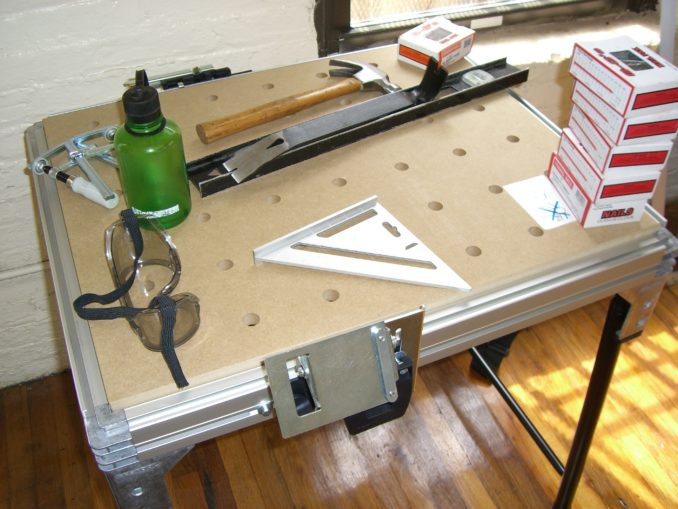
Images Becky Stern – Licence CC BY-SA 2.0
I want to talk about the things that you can do.
I am one of those annoying people who is good at everything that they do.
Like a Renaissance man idea or you could say a dilettante, or somebody who has wasted their time.
One of those.
So drawing:
I like F pencil leads, just a little bit harder than HB.
If you are doing a lot of drawing you can get an electric pencil sharpener, a bit noisy but all you are doing at that time is sharpening a pencil.
I am astonished at how expensive some materials are today I’m sure they didn’t used to be so much.
A brush can be a hundred quid.
With pencils it doesn’t really matter how much they cost but if you want to sharpen them mechanically then the lead should be exactly in the middle of the wooden bit or the bit that you are interested in, the point, will be not good to use.
Clutch pencils are sort of OK, there is a device with an off centre ball with a hole in it that guides the point over an abrasive which is the only thing I came across that was usable.
Propelling pencils are OK to write with but the point is not good for any sort of control.
I did a fair bit of drawing with a rapideograph, you can do some old looking type images with those.
I lost all mine somewhere but collected many last year. I cleaned them all with an ultrasonic machine with vinegar and they all work but they are still in a box waiting to be loved.
painting
I like water colour, I’m technically not bad but a bit blocked at the minute with what I want to do. So that is really up to you.
airbrush:
airbrushing is good for smooth tones, you can draw with an airbrush but people use stencils, the trick with stencils is to work out first how you are going to us them and in which order, swivel knives are good for cutting out the stencil. they are a tiny little blade on a bearing swivel. the trick is to keep your hand a little bit ahead of the point and pull it where you want it to go, takes a couple of hours to get used to.
devilbis are very usable and you can clean them out. for anything bigger there was the type MP which can handle a variety of gloopyness of materials. or if you are a graffiti artist you can use a pressurized spray can of paint.
sand blasting:
you can etch glass by blowing an abrasive under pressure the same way you use a spray gun.
etching:
I like the look of etching but I never did any, I don’t think, did offset litho but that is not the same. I used to cheat and use lino cut but most successful impersonation was scraper board. those old etchers were really good at it, varying the width of the cut to give tones, you can fake that with scraper board.
3D things sculpture and that.
This is where it gets interesting, there is so much that you can do.
You choose the material for how you want to work it.
For some things I would make a shape roughly the way it should be then make a mould of that in rubber or plaster then make a plaster positive from that and work on that with chisels or power tools. then do whatever from that pattern.
it can be glass, bronze or anything that goes liquid for a bit.
you can stick all sorts of organic, inorganic material together, cast it then work on that.
the traditional way is to make a wax (that you can steal from bees, or buy the harder sort ) not knowing exactly the formulas for waxes at the minute.
then coat the wax in a refractory material, melt out the wax and pour in the metal then spend ages trying to make it look nice with hammers and chisels or grinders. There is some experience to have about the runners and risers.
I made a 12 foot bronze once and they duplicated it in polystyrene first which just melted out into nothing like wax does.
I like papier mache as well as it is not so messy.
I think I might do some more of this 3D stuff.
Glass
there is a lot you can do with glass, I was attracted to it because it is sort of old.
you can slump it, cast it, blow it when molten, cut it, polish it, mix all colours with it, develop a handling technique with you and a few others.
How did they do that ?
Time was a guy from Murano would put your eyes out if you saw.
Pottery
Pottery is a bit like glass but you work with it when it is cold and then make it hot and hope for the best.
Any of the casting techniques work with clay but there is the one thing that is slip casting where you make a plaster mould, pour wet clay into it and the plaster absorbs the water from the clay and you have a skin of clay attached to the inside of the mould, pour the surplus away and you have a hollow clay form.
Wood carving.
I like wood, again it is old. I had a phase of making wooden copies of real objects like paper parcels.
need sharp chisels and get to know the piece of wood, go with the grain or bits will fly off you rather had stayed put.
any of the fruit woods are good, sycamore is OK, I made some little chairs in lime wood once which was surprisingly good for small things, slow growing tight grain is good.
leather.
you can shape leather over a form if it is wet. I always fancied making one of those embossed American saddles.
Photography.
I did a lot of that when it was plastic film coated in chemical layers.
The only thing you need to know is that a small hole for a long time lets through the same amount of light as a big hole for a short time.
the numbers f4, f5.6, F8, f11, f16 size of the hole are related to the shutter time 1/60 1/125 1/250 1/500 halving or doubling the light that get to the film/sensor 1/500 at f4 is the same as 1/60 at f11. in the first case moving things will be sharpish and the depth of the focus will be short whereas the other the motion might be a bit blurred but more will be in focus with the same sensitivity of the film/sensor (ISO).
I think ISO on a digital camera must be to extend the range in a tidy fashion. Oh, with a digital camera if it is overexposed it is gone forever, best to slightly under expose.
anyway with the digital photography here are the softwares I used.
combineZM
combineZP
Autopano
devalVR
exiftool
flashpano2VR
HD view utilities
Hugin
enblend-enfuse
PTLens
Smartblend
autopano
KRpano
Object2VR
pano2Vr
Panorama tools
photomatix
pt assembler
PTGui
VR toobox
Zoomify
fdrtools
ptviewer
fdrcompressor
processing
ptsticher
smartblend
gimp
photoshop
Is all a few years old so perceived knowledge might have changed.
animation
if a thing goes from A to B in the same frames to slow down the start you put more drawings there, to slow down the end you put more drawings there. That’s it.
embroidery
very time consuming
But you say what about 3D printing and computer graphics ?
I don’t do that.
I did oversee the first computer generated animated commercial in the UK when they didn’t know what they were doing but that was ages ago.
What shall I make ?
Well there is some advice.
In each and every shitty idea there is a great idea waiting there to be found if you can examine your motives for doing that thing.
© Gotham must be destroyed 2017



